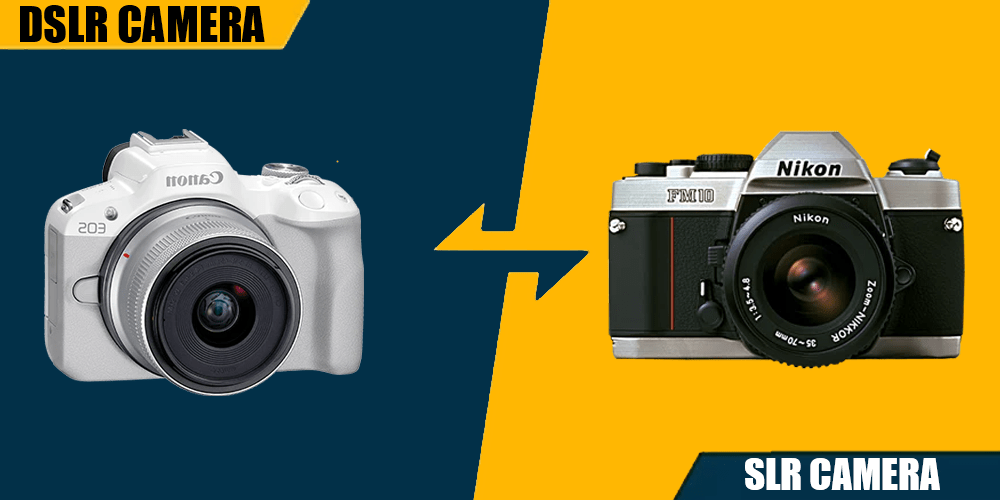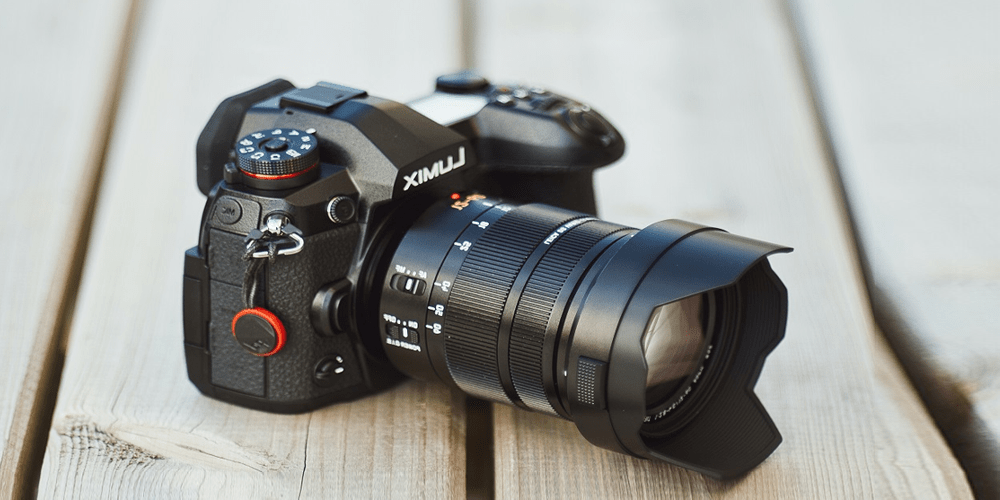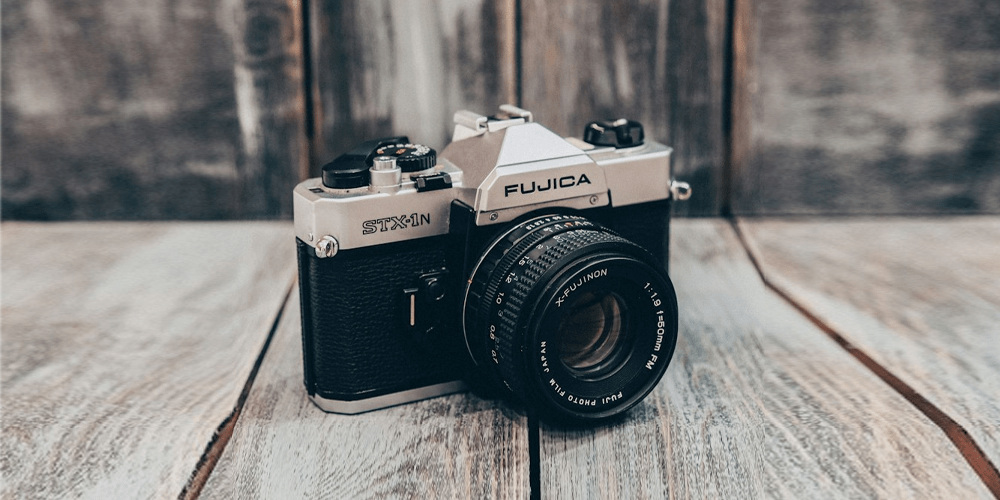DLSR Vs. SLR Camera: If you’re in the market for a new camera, you may wonder whether a DSLR or an SLR digital camera is the best option. Both types of cameras have pros and cons, so it’s important to understand the difference between them before deciding.

What are the differences between DSLR and SLR Digital cameras: DSLR Vs. SLR
DSLR Digital Camera
A DSLR camera is a digital single-lens reflex camera that uses a mirror to reflect the image captured by the lens onto an electronic viewfinder. An SLR camera is a film single-lens reflex camera that uses a mirror to reflect the image captured by the lens onto a film negative.
DSLRs are typically more expensive than SLRs, but they offer many advantages, including previewing the image before taking the picture and storing images in digital formats. DSLRs also tend to be smaller and lighter than SLRs, making them more portable.
SLR Digital Camera
SLR digital cameras are less expensive than DSLR cameras but don’t offer the same features and benefits. One advantage of SLR cameras is that they’re easier to use since you don’t have to worry about previewing the image or storing it in a digital format.
However, SLR cameras are typically larger and heavier than DSLR cameras, making them less portable. Additionally, SLR cameras don’t generally offer the same level of image quality as DSLR cameras.
So, which type of camera is right for you? A DSLR camera is a way to go if you want the best image quality and features.
However, an SLR digital camera may be a better option if you’re on a budget or don’t need all the bells and whistles. Ultimately, the decision comes down to your specific needs and preferences.
What is DSLR?
A DSLR camera, also known as a digital single-lens reflex camera, is a high-end camera that allows the user to change lenses and offers manual controls for capturing photos. They have a clear viewfinder that displays what the lens sees in real-time, unlike mirrorless cameras that display the image on a screen.

These cameras also have larger sensors, allowing for greater detail and high-quality images. DSLRs are popular among professional photographers due to their durability and flexibility in shooting options.
However, they can also be more expensive and heavier compared to compact or mirrorless cameras. Overall, DSLR cameras offer more control and quality for those looking to invest in a high-end photography device.
Pros:
- They offer manual controls for those who want more creative freedom with their photos.
- They have a clear viewfinder that displays what the lens sees in real-time.
- Their sensors are larger, resulting in higher-quality images.
- DSLRs are popular among professional photographers due to their durability and flexibility.
Cons:
- They can be more expensive than other types of cameras.
- They are often heavier and bulkier, making them less portable.
- Their complex features can be overwhelming for beginners.
What is SLR?
SLR, or single-lens reflex, cameras have been the preferred tool of professional photographers for decades. This type of camera uses a movable mirror system to allow the photographer to see through the lens, providing an accurate preview of the shot they will capture. In addition, SLR cameras typically offer interchangeable lenses and manual control over shutter and aperture settings, allowing for more artistic flexibility and precise adjustments.

While SLR cameras are often larger and heavier than their compact counterparts, they provide superior image quality and a more comprehensive feature set. Whether shooting on film or digitally, SLR cameras continue to be a go-to choice for professionals in the industry.
Pros:
- They offer a true preview of the shot, thanks to the movable mirror system
- They generally have interchangeable lenses, giving you more creative control
- They offer manual controls over shutter and aperture settings
- They tend to be larger and heavier than compact cameras
- They produce superior image quality thanks to the larger sensor size
Cons:
- They can be more expensive than compact cameras
- They require more upkeep, such as regularly cleaning the sensor
- They can be more difficult to use for novice photographers
- They tend to be larger and heavier than compact cameras, making them less portable.
- They can have a steep learning curve for novice photographers.
Key Differences between DSLR and SLR Cameras
Video Recording
One key difference between DSLR and SLR cameras is their ability to record videos. DSLR cameras typically have better video recording capabilities, allowing for higher resolution and frame rates.
In addition, most DSLRs offer features such as autofocus while filming and the ability to attach external microphones. On the other hand, traditional SLRs often do not have video recording capabilities at all.
Lens
One of the defining features of a DSLR or SLR camera is the ability to use interchangeable lenses. This allows photographers to adapt their equipment to different scenarios and capture a wider range of subjects.
Whether it’s a lightweight prime lens for on-the-go street photography, or a telephoto lens for wildlife photography, having the option to switch out lenses can greatly expand a photographer’s creativity. Interchangeable lenses also allow for fine-tuned control over aperture, focal length, and other details, resulting in higher-quality images.
So if you’re looking for flexibility and versatility in your camera equipment, consider the interchangeable lens feature offered by DSLR and SLR cameras.
Storage
When it comes to image storage, DSLR and SLR cameras operate differently. DSLRs use memory cards to store images, while SLRs often have film rolls. This difference can affect the number of images taken before running out of storage.
For example, a memory card with 64GB can hold thousands of images, while a roll of 35mm film can only hold up to 36 exposures. In addition, memory cards allow for easy transfer and editing of images, while film must be developed before being viewed or manipulated.
However, some photographers prefer the unique qualities of film and appreciate the constraints it imposes on their shooting style. Ultimately, each photographer’s preference for memory cards or film is a personal choice.
Shutter Speed
DSLR cameras have a clear advantage over their SLR counterparts. DSLR cameras often have faster shutter speeds, allowing for crisper and clearer action shots. In addition, DSLR cameras typically offer a wider range of shutter speed options, giving photographers more flexibility in capturing the moment.
However, it’s important to note that shutter speed is just one factor in determining the quality of a photo. A professional photographer with an SLR camera can still capture outstanding images with careful planning and technique.
Ultimately, choosing a camera should consider all factors, including cost, aesthetics, and available features. Shutter speed is important, but it shouldn’t be the only one.
Price and Value
Another key difference between the two is their price: DSLRs tend to be more expensive and come with a larger price tag. However, this does not necessarily mean that DSLRs offer more value for your money. Both types of cameras have their benefits and drawbacks, and ultimately it’s up to the photographer to decide which features they need and are willing to pay for.
It’s important to consider not just the initial cost of the camera but also its potential future value, such as in resale or trade-in opportunities.
Ultimately, determining a camera’s value is how well it suits your needs and how effectively you use it to capture your desired images. So while the price may be a factor in choosing between a DSLR and an SLR camera, it should not be the sole determining factor in selecting the right one for you.
Benefits of having a DSLR Cameras Over SLR
DSLR cameras offer many advantages over traditional SLR cameras, including previewing the image before taking the picture and storing images in digital formats.
DSLRs also tend to be smaller and lighter than SLRs, making them more portable. In addition, DSLR cameras offer a variety of features that are not available on traditional SLR cameras, such as live view and video recording.
Professional Photographers
Professional photographers rely on top-notch equipment to capture the perfect shot. While SLR cameras may be convenient, they don’t have the capabilities of a DSLR camera.
DSLR cameras offer greater control over various features, including aperture, shutter speed, and ISO. This allows photographers to manipulate lighting and achieve a shallow depth of field for stunning portraits.
Additionally, DSLRs have superior autofocus capabilities and can capture images faster, making them ideal for action shots or events. As technology advances, DSLRs can also shoot in extremely low light conditions and at higher megapixel counts. Professional photographers see the value in investing in a DSLR camera to elevate their craft and deliver top-quality images to their clients.
Amateur Photographers
Amateur photographers often start using smartphones or small SLR cameras, but investing in a DSLR camera can greatly enhance their skills and capabilities.
DSLRs offer manual settings that allow more control over factors like exposure and depth of field. In addition, DSLR cameras have superior low-light performance and sharper zoom capabilities.
They also typically have interchangeable lenses, allowing Amateur photographers to experiment with different types of photography, such as portraits or landscapes. Overall, Amateur photographers will significantly improve the quality and range of their photographs by upgrading to a DSLR camera.
Why Should You Invest in a DSLR Camera?
Many people believe that smartphones are enough for basic photography needs. However, DSLR cameras offer customization and control that smartphone cameras cannot match. Investing in a DSLR camera allows you to fully explore your creativity and take your photography skills to the next level.
DSLR cameras also provide higher-quality photos, with the ability to capture more detail and a wider range of colors.
In addition, DSLR cameras have better low-light performance and can usually handle shooting in RAW format, giving you greater flexibility in post-processing.
Overall, investing in a DSLR camera is well worth it for both hobbyists and professional photographers. It opens up new possibilities for creative expression and helps improve your photos’ overall quality.
Final Words: SLR Vs. DSLR Cameras
As technology advances, the lines between DSLR and SLR cameras are becoming increasingly blurred. Both offer a vast array of features and capabilities, but ultimately it comes down to personal preference.
DSLRs have become more compact recently, offering convenience for travelers or anyone wanting a smaller camera option.
However, SLRs remain the go-to choice for professional photographers due to their larger sensors and interchangeable lenses.
There is no clear winner in image quality, as both can produce stunning results in the hands of a skilled photographer.
Choosing the camera that best fits your individual needs and shooting style is important. Whether a DSLR or an SLR, as long as you have the passion and drive to improve your skills, you can capture beautiful photographs.
